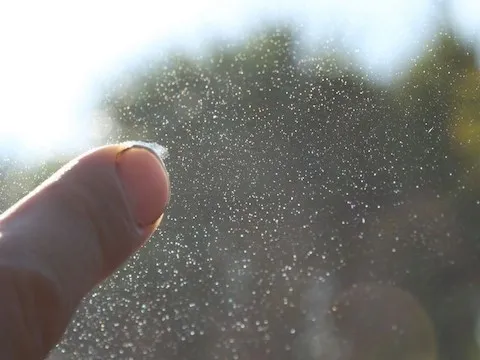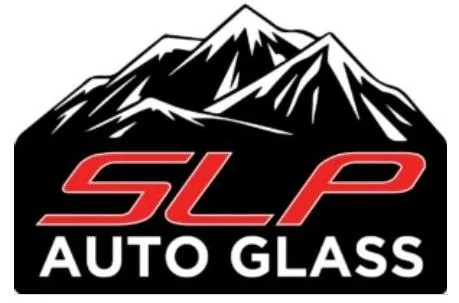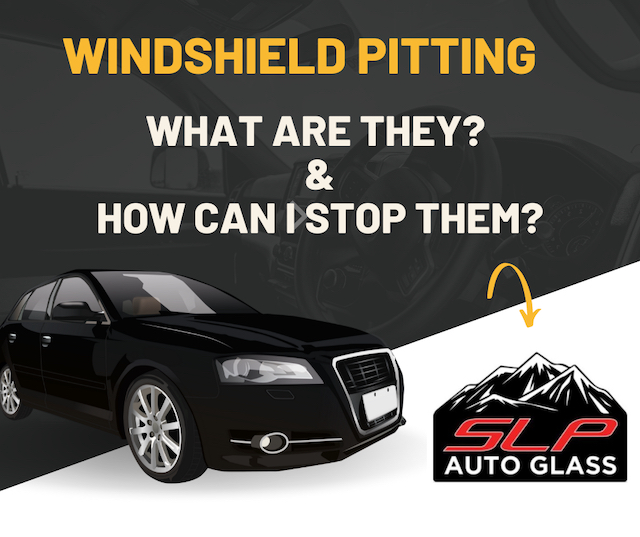As an auto glass repair company, we’ve spent countless upon countless pages writing about the dangers of windshield chips and cracks. The horror of finding a crack splattered across your windshield is undeniable, and in most circumstances, immediate. If the damage is significant enough to cause dismay, it’s likely big enough to be seen within seconds. Windshield pitting, on the other hand, is a silent killer of all auto glass.
You may believe that your windshield is in perfect condition, but when the blinding afternoon sun strikes the glass, something disheartening appears. Small and tiny dots are throughout the entirety of your windshield, causing both obscured vision and the increased intensity of sunlight. You believe it’s just debris, but after a quick clean, you realize it’s not going anywhere.
Welcome to windshield pitting, an often overlooked form of windshield damage.
What Is Windshield Pitting?
A modern windshield is made of two panels of tempered glass with a resin between them. This combination creates a safer driving experience. If one of the panes of glass is damaged (from, say, an accident), the broken shards stick to the resin in between, saving the other side from shattering glass. Ultimately, this is why a shattered windshield doesn’t immediately break into the car’s interior.
When there is an abundance of high-flying debris (i.e. sand, salt, dirt) constantly hitting the windshield, it eventually creates small holes in the outside pane, getting stuck somewhere in the middle. If you drive on the highway daily (especially during Colorado winters), you are facing tiny debris all the time. Driving highway speed causes the debris to smack into the windshield. With enough time, those minuscule grains will start to add up, creating windshield pitting.
Ultimately, pitting is a common and natural issue with all windshields. Unfortunately, we live and drive in a world full of small specks. It’s almost impossible to avoid while driving your daily commute.
Below is an example of windshield pitting for you visual learners.

Provided by AutoGeekOnline.
Is It Different Than Cracks and Chips?
Thereotecially, no. Windshield pitting is the same physical damage as cracks and chips, just on a tinier level. If a normal-sized rock hitting your windshield causes a chip, a micro rock hitting your windshield causes a pit. Same physical concept.
The difference is the overall effect. While a chip or crack makes an immediate impact on your driving vision and can affect the integrity of your vehicle’s roof during a collision, pitting is less of a significant danger. Mostly, pitting will cause a reflection of light (especially sunlight), obscuring your driving vision by increasing glare and spreading rays.
If you have windshield pitting, you will notice a drastic increase in sun glare while driving. While that’s not an obvious impact on your car’s safety, it is dangerous for the driver. Even pitting on a window or passenger-side windshield can affect the driver’s vision at the right angle. At the end of the day, you never want to drive with something affecting your vision.
Will It Get Worse?
We often drive home the concept of getting your windshield cracks repaired or replaced immediately. Yes, it’s a bit of advertising as a windshield repair company, but the importance is not just a selling point. As we stated, a damaged windshield affects the overall integrity of your car’s roof. it also helps with the correct deployment of airbags. A sturdy windshield is more important than just seeing.
Pitting, on the other hand, is not as significant of an issue. As stated, it mostly just affects vision and aesthetics. While scientifically it may be reducing the windshield’s integrity (if not just marginally), it’s not as drastic as a full crack.
We also say to get your windshield repaired immediately because cracks and chips will quickly spread, making repair costs higher. Fortunately, that isn’t the case with pitting. While pitting will continue to happen during your drive, the pits themselves will not get bigger. You will get more, but it’s not due to having some already.
Regardless, we still recommend getting your windshield repaired once the pits become overwhelming. Once they are affecting your driving vision, assistance is needed.
How to Avoid It?
All in all, you can’t avoid the wear and tear of daily driving. If you need to drive through areas with debris, sand, or salt, you are going to get windshield pitting. As stated, it’s a natural development for all windshields. It’s impossible to avoid these natural dangers, especially if you are driving at highway speed.
Theoretically, you could significantly lower your chances of pitting if you avoided highways or going fast. That’s a tough ask, though.
Furthermore, tint would technically reduce pitting. Being an outside layer, the tint would get most of the debris damage, causing pitting in the tint itself. You would still have to get the tint replaced once it begins to become damaged. Unfortunately, it’s illegal to have tint on your front windshield (below the top four inches), so that technique is out the window.
Henceforth, pitting is going to happen over time. Depending on where you live, it may take years to become noticeable or significant. It will still happen eventually, though.
Can Windshield Pitting Be Fixed?
A quick Google search may result in a plethora of forums claiming to have found the mystical fix for windshield pitting.
Unfortunately, windshield pitting can only be fixed by a full replacement. Unlike chips and cracks, there is no way to fill in the miniature holes with a resin injection, increasing the integrity of the glass. Pits are too tiny to fill and often too abundant to be worth the time.
There are some ‘experts’ that claim to be able to fix pitting through polishing or filling, and while we won’t argue that this is possible, it should be avoided. Polishing the windshield would only reduce the glass in the specific area, causing an uneven and weak windshield. We already noted how important a windshield’s integrity is to your driving safety, so playing with it is not suggested.
If your windshield only has a few pits, it’s entirely okay to continue driving on it. A full replacement is only needed when it becomes abundant, unsightly, or impacts your driving vision.
Need Auto Glass Replacement?
At SLP Auto Glass, our experienced auto glass technicians can handle any form of windshield. We can fix or replace anything from pitting to spider cracks. Furthermore, we only use the highest-grade materials available.
Ultimately, we strive to make the windshield-replacement process simple and efficient. We understand how stressful it can be and how important your auto glass is. We will answer any questions and handle any problems you have, including contacting your insurance company.
Need mobile services? We offer those, too!

